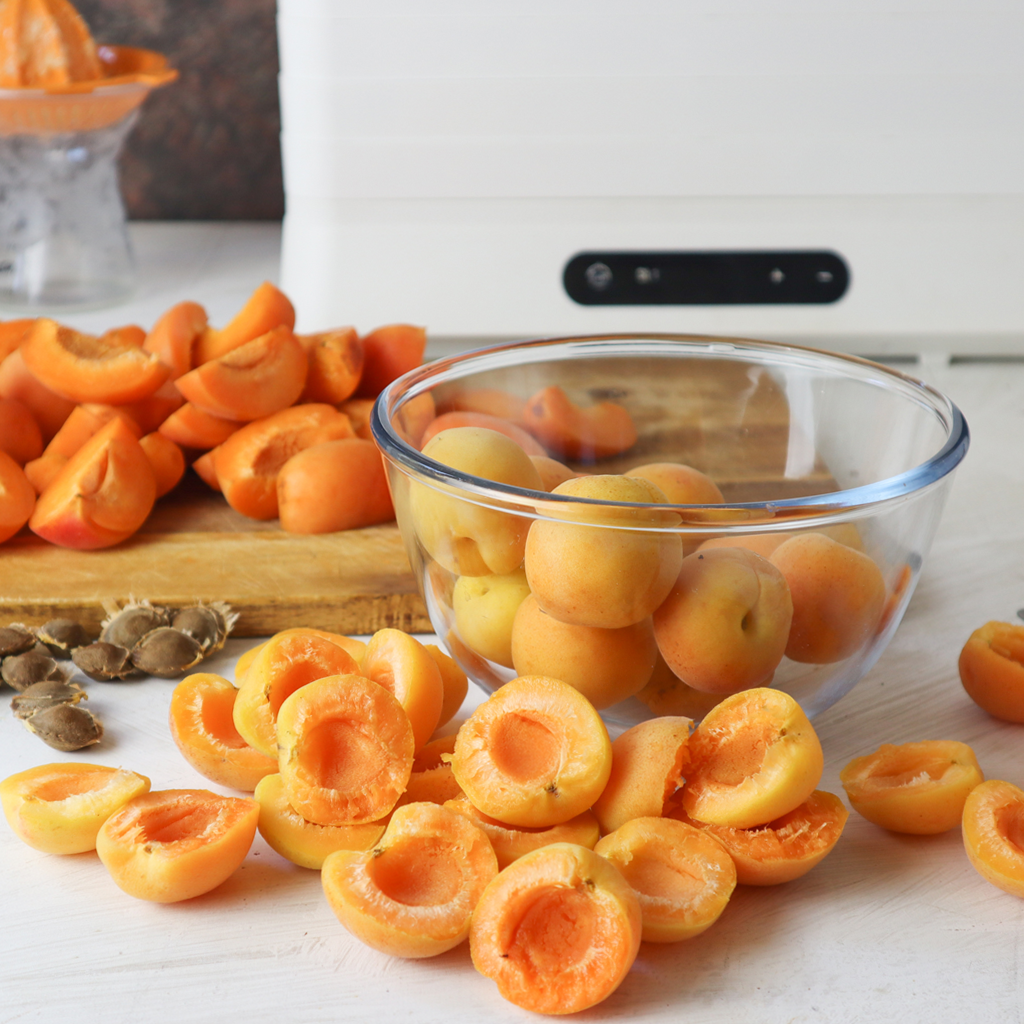Your Cart is Empty

How to dry Apricots in a food dehydrator
Barb Hodgens
Barb Hodgens loves to cook with alternative, healthy whole food ingredients, with a focus on gut health. Barb has overcome her own gut health issues through healthy eating. Share your ideas, comments and photos at the end of this post :)
Healthy, sweet snacks available all year.
Drying apricots in the Breeze Food Dehydrator is a great way to keep the flavours of summer alive all year. Dried apricots make a lovely, sweet, chewy snack perfect for packing into school lunch boxes, your handbag or desk draw. Homemade dehydrated apricot is also delicious added to yogurt, homemade cereal, muesli bars, or your favourite muffins.
Store-bought dried apricots, the ones that are bright orange and tender, have been treated with preservatives to retain the colour and keep them soft. Without sulphates, apricots naturally lose their lovely intense orange colour as the moisture leaves the fruit. Even with a pre-treatment, homemade dehydrated apricots will be dryer and darker in colour. Good news - the process of dehydration, intensifies the sweetness making the homemade variety burst with flavour.

WATCH HOW HERE
INGREDIENTS
Fresh apricots
METHOD
1. Buy or pick your apricots when they are fully ripe and still a little hard; this is when they have the most flavour and are not too mushy to dehydrate successfully. Note: Apricots ripen from the centre and in warm weather they can quickly become over-ripe and ferment around the seed.
2. Discard mouldy fruit.
3. Wash your apricots in cool water to remove any dirt just prior to use. Once washed, water can also get inside the core and start to rot the apricot from the inside.

4. Thoroughly dry the fruit. (skip this step if you are applying a pre-treatment)
5. Slice the apricots along the seam and split in half with your fingers. If the apricots are ripe enough, you can do this with just your thumbs and no knife. You don't have to peel apricots.
6. Any badly damaged area on the apricot should be cut off.
7. Cut large apricots into quarters.
8. Pre-treating apricots is optional. If you won’t be consuming your dehydrated apricots within 2-3 months you may want to pre-treat the fruit to prevent them going darker in storage. This can be done using 1 cup fresh lemon juice to approx. 1-litre of water. Halve the solution for smaller quantities. In a large bowl, combine water and lemon juice. Add the apricots and let sit in the acidic solution for 5 minutes. Remove from the bowl, shaking off as much liquid as possible.
9. Lay the apricots cut side facing up on the trays. If you have larger and smaller apricots. Keep like-sized apricots on the same tray to make for even drying.
10. Set the dehydrator to 60°C (140°F) and the time to 12 hours to check in. It may take up to 24 hours or more to fully dry apricots. Pre-treated apricots take a little longer to dry. The dehydrating time will vary depending on the thickness and size of the apricots and the humidity in the air.

11. After 12 hours, take each apricot half and press up gently with your thumb to turn the fruit partially inside out. This will help to expose the moist centre to the air and speed along the drying process.
12. Set the timer for another 6 hours to check in again.
13. The apricots will be sticky at first, but as the water is taken away, they will begin to firm up. Bright orange patches indicate the fruit is not dried.
14. Allow to cool completely to best test for moisture.
15. When dried, apricots should be soft, leathery and pliable, with no juice if cut or squeezed. Because of the thickness of apricots, they are one of the more difficult fruits to judge if dried. If the apricots are destined for long term storage, we recommend slightly over-drying or condition before storage. Remove pieces that are dried.
16. Make sure the apricots are completely cool before storing. Keep dehydrated apricot in airtight jars or vacuum seal and store in a cool, dark place.
PIN THIS RECIPE

How to dry Apricots in a food dehydrator
Healthy, sweet snacks available all year.
Drying apricots in the Breeze Food Dehydrator is a great way to keep the flavours of summer alive all year. Dried apricots make a lovely, sweet, chewy snack perfect for packing into school lunch boxes, your handbag or desk draw. Homemade dehydrated apricot is also delicious added to yogurt, homemade cereal, muesli bars, or your favourite muffins.
Store-bought dried apricots, the ones that are bright orange and tender, have been treated with preservatives to retain the colour and keep them soft. Without sulphates, apricots naturally lose their lovely intense orange colour as the moisture leaves the fruit. Even with a pre-treatment, homemade dehydrated apricots will be dryer and darker in colour. Good news - the process of dehydration, intensifies the sweetness making the homemade variety burst with flavour.

WATCH HOW HERE
INGREDIENTS
Fresh apricots
METHOD
1. Buy or pick your apricots when they are fully ripe and still a little hard; this is when they have the most flavour and are not too mushy to dehydrate successfully. Note: Apricots ripen from the centre and in warm weather they can quickly become over-ripe and ferment around the seed.
2. Discard mouldy fruit.
3. Wash your apricots in cool water to remove any dirt just prior to use. Once washed, water can also get inside the core and start to rot the apricot from the inside.

4. Thoroughly dry the fruit. (skip this step if you are applying a pre-treatment)
5. Slice the apricots along the seam and split in half with your fingers. If the apricots are ripe enough, you can do this with just your thumbs and no knife. You don't have to peel apricots.
6. Any badly damaged area on the apricot should be cut off.
7. Cut large apricots into quarters.
8. Pre-treating apricots is optional. If you won’t be consuming your dehydrated apricots within 2-3 months you may want to pre-treat the fruit to prevent them going darker in storage. This can be done using 1 cup fresh lemon juice to approx. 1-litre of water. Halve the solution for smaller quantities. In a large bowl, combine water and lemon juice. Add the apricots and let sit in the acidic solution for 5 minutes. Remove from the bowl, shaking off as much liquid as possible.
9. Lay the apricots cut side facing up on the trays. If you have larger and smaller apricots. Keep like-sized apricots on the same tray to make for even drying.
10. Set the dehydrator to 60°C (140°F) and the time to 12 hours to check in. It may take up to 24 hours or more to fully dry apricots. Pre-treated apricots take a little longer to dry. The dehydrating time will vary depending on the thickness and size of the apricots and the humidity in the air.

11. After 12 hours, take each apricot half and press up gently with your thumb to turn the fruit partially inside out. This will help to expose the moist centre to the air and speed along the drying process.
12. Set the timer for another 6 hours to check in again.
13. The apricots will be sticky at first, but as the water is taken away, they will begin to firm up. Bright orange patches indicate the fruit is not dried.
14. Allow to cool completely to best test for moisture.
15. When dried, apricots should be soft, leathery and pliable, with no juice if cut or squeezed. Because of the thickness of apricots, they are one of the more difficult fruits to judge if dried. If the apricots are destined for long term storage, we recommend slightly over-drying or condition before storage. Remove pieces that are dried.
16. Make sure the apricots are completely cool before storing. Keep dehydrated apricot in airtight jars or vacuum seal and store in a cool, dark place.
PIN THIS RECIPE

Subscribe
Sign up to get weekly healthy recipes & information on new product releases.
Item is added to cart



